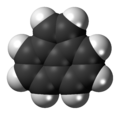| |||
| Names | |||
|---|---|---|---|
| Preferred IUPAC name Acenaphthylene [1] | |||
| Other names Cyclopenta[de]naphthalene Acenaphthalene Tricyclo[6.3.1.04,12]dodeca-1(12),2,4,6,8,10-hexaene[ citation needed ] Tricyclo[6.3.1.04,12]dodecahexaene[ citation needed ] | |||
| Identifiers | |||
3D model (JSmol) | |||
| ChEBI | |||
| ChemSpider | |||
| ECHA InfoCard | 100.005.380 | ||
PubChem CID | |||
| UNII | |||
CompTox Dashboard (EPA) | |||
| |||
| |||
| Properties | |||
| C12H8 | |||
| Molar mass | 152.196 g·mol−1 | ||
| Appearance | Yellow crystals | ||
| Density | 0.8987 g cm−3 | ||
| Melting point | 91.8 °C (197.2 °F; 364.9 K) | ||
| Boiling point | 280 °C (536 °F; 553 K) | ||
| Insoluble | |||
| Solubility in ethanol | very soluble | ||
| Solubility in diethyl ether | very soluble | ||
| Solubility in benzene | very soluble | ||
| Solubility in chloroform | soluble | ||
| Thermochemistry [2] | |||
Heat capacity (C) | 166.4 J mol−1 K−1 | ||
Enthalpy of fusion (ΔfH⦵fus) | 186.7 kJ/mol | ||
Enthalpy of vaporization (ΔfHvap) | 69 kJ/mol | ||
Enthalpy of sublimation (ΔfHsublim) | 71.06 kJ/mol | ||
| Hazards | |||
| GHS labelling: | |||
  | |||
| Danger | |||
| H302, H310, H315, H319, H330, H335 | |||
| P260, P261, P262, P264, P270, P271, P280, P284, P301+P312, P302+P350, P302+P352, P304+P340, P305+P351+P338, P310, P312, P320, P321, P322, P330, P332+P313, P337+P313, P361, P362, P363, P403+P233, P405, P501 | |||
| Flash point | 122 °C (252 °F; 395 K) | ||
| Related compounds | |||
Related compounds | acenaphthene | ||
Except where otherwise noted, data are given for materials in their standard state (at 25 °C [77 °F], 100 kPa). | |||
Acenaphthylene, a polycyclic aromatic hydrocarbon is an ortho- and peri-fused tricyclic hydrocarbon. The molecule resembles naphthalene with positions 1 and 8 connected by a -CH=CH- unit. It is a yellow solid. [3] Unlike many polycyclic aromatic hydrocarbons, it has no fluorescence.

